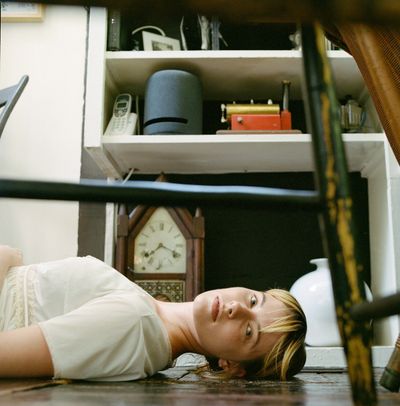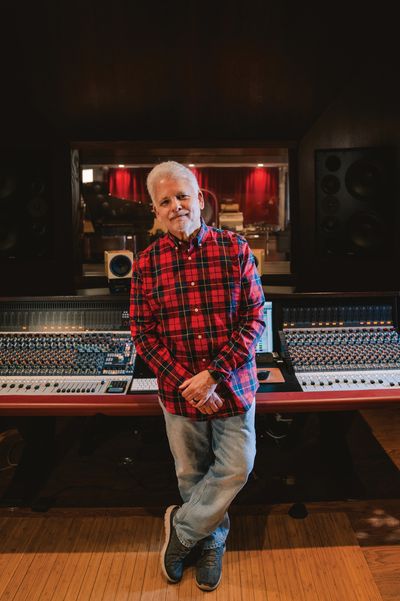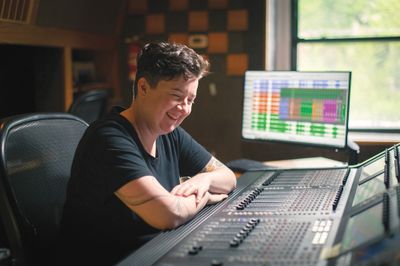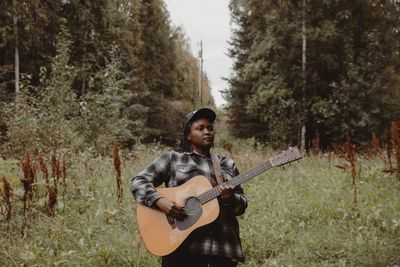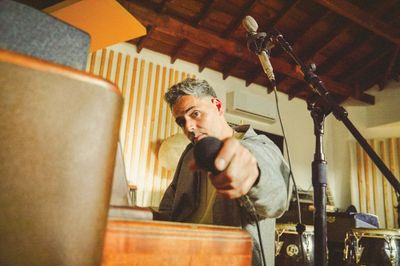What equipment are you using for your Virginia field recordings ("Dogs in the Yard, Birds Overhead")?
I feel really fortunate to have been able to vastly upgrade my recording rig in the last year. In the past, I would go out into the field, including the Brazilian Amazon, with a small Sony DAT recorder and any affordable, handheld stereo mic. I'd also bring an assortment of contact microphones and small binaural mics. I had some success with a Crown SASS mic [PZM stereo]. At the moment, I am using a Sound Devices 722 hard disk recorder, a Schoeps CMXY stereo [condenser] mic and a Sennheiser MKH short shotgun microphone. I bring along a mic stand but also a pistol grip and short boom pole. The Sound Devices is an amazing machine. It has excellent preamps as well as a 40 GB hard drive. I generally record at 24 bit, 96 k. The Schoeps in particular captures high frequencies like nothing else I know of. The recordings I've been doing will end up in various forms, both as multi-channel installations as well as stereo tracks for an upcoming CD on the Portuguese label, SIRR. I don't have the ability to record in surround so I will often process stereo tracks with a very nice plug-in, ARL Sound Stage, that my friend Paul Geluso worked on. Some of the recordings remain fairly pristine; others are mangled and played with. I've been using Ableton Live for several years for mixing and processing, but recently I am trying to stay a bit outside the box, using a small Doepfer analog suitcase-style synth as a processor. It's all been a bit of a learning curve — recording with something as sensitive as the Schoeps means either leaving the mic to record alone and/or learning to do as little breathing, moving or twitching as possible. When I first got it, I thought there was some problem with an occasional cracking noise that I heard through the headphones. I eventually realized it was the sound of my wrist! One of the most amazing sites I've been recording in recently is a newly discovered forest about two hours south of Richmond. The forest is incredibly quiet. Occasionally an owl will call out in the late afternoon. I've also heard the inevitable boom and splash of trees falling in the distance.
How have your techniques changed from when you first started recording outside of the home/studio environment?
A lot of my original recordings were in New York. I did recordings inside the World Trade Center using contact microphones on the windows. I did recordings in Grand Central Station (an amazing acoustic chamber) — subways, streets, shipyards. In all of those cases, the equipment was small and there was enough noise around that I could just use the mic as an extension of my arms, hands as well as head with the binaurals. With this new setup, and often in much quieter environments, I've found that I have to become invisible and silent. I do all that I can to allow the microphone to capture the environmental sounds as they would exist if I weren't there. I found out early on that this too is not always entirely possible. I was recording in a marsh inside of James River State Park. I'd been there several times, falling in love with the balance of insects, birds, crickets and bullfrogs. I had my microphone on a boom pole, stuck through some thicket. I couldn't exactly see what the microphone was recording. Suddenly I heard a whoosh and a high frequency breathy sound that would speed up and stop. I thought it might be an owl, maybe a jabberwocky. I posted the sound to the sound recordists list serve and was told by two members of this group that it was the warning call of the young white tailed deer. I had been spotted and she was sending out the signal for all deer to stay away! I've learned a great deal from following the sound recordists group. One difference of what I do compared to many on the list is they are often focused on very specific bird groups and animal species. I'm not as interested in which sort of bird I'm hearing, but more in the experience of listening and how sound affects our connection to a particular environment as well as our own mind and body.
I've seen you demonstrate a photocell microphone that you and Bob Bielecki created for the 1999 World Trade Center recordings. Will you explain the process and components used to make these?
This came about during my residency in 1999. I wanted to find a way to have sound correspond with the incredible light that would fill my studio. Bob Bielecki is a friend as well as a brilliant engineer. He was coming up to check out my studio and conveniently had a pocketful of photocells. Photocells are used in all sorts of electronics. Just as they can be used to register intensity of light they can also be used to amplify the audible frequencies of light. Bob attached an audio cable to the photocell and built a little circuit for a 9-volt battery to give power and placed the photocell inside a former XLR housing. We were able to listen to the sound of lights inside my studio (the small red light on the mixing board, the green glow from a multi- effects unit) as well point the photocell into the eye of a telescope, allowing us to listen to the flashing lights of a police car across the river and the red glow of the Colgate clock, also across the Hudson River.
Have you used these for subsequent recordings?
I used the photocell as an instrument on my CD Bright and Dusty Things [New Albion Records]. I would amplify the lights in the studio and then process them through whatever was on hand, most often a Digitech 8-second delay and a Moogerfooger Ring Modulator.
What makes you gravitate to these two pedals?
I really love the sound of the Moog Ring Modulator. I remember when I first got it I was doing a performance with Joan Jeanrenaud (former cellist for the Kronos Quartet). Joan was playing through my board so I could add processing. There was a richness that it caught in her cello sound that felt warm and organic. I sometimes use the LFO output on the Moog and send it to a [Bixonic] Expandora distortion box to add some clicks and pops. I had wanted to get one of the Moogerfooger Analog Delays, but couldn't afford it. I did buy a very nice analog delay called a Diamond Memory Lane. The Digitech delay is not necessarily amazing sounding, but I like the option of grabbing loops and then being able to use the pitch/time manipulation to slow the loop down or up. I know there are all sorts of newer models that offer longer looping times and probably better resolution, but I'll just stick with this one until it breaks down.
When you are collaborating with Scanner or Andrew Deutsch, do you have a system set up for how you will be sharing sounds, tracking, mixing, etc.?
It's really project-by-project. I have been involved in a number of collaborative projects where we are sending material back and forth. Andrew and I are just finishing a CD that started with some music box recordings I did and then gently processed. He sent them back to me with a really amazing, aggressive punch. I added more punch, but then he sent them back to me again calmer and sweeter, more like a music box except that at this point, there are so many levels of processing that you would never know that that was the source material! Robin Rimbaud (Scanner) and I have done similar exchanges. Andrew teaches in the electronic arts program at Alfred University in upstate New York. The system that he has at school is analog and digital. They have some beautiful analog processors including several Doepfer synthesizers, but also locked away are some Bode processors that are owned by another instructor, Peer Bode. Peer's father Harald was a very important electronic instrument builder. Moog among others has been quoted as being influenced by the Bode designs. Peer has an incredible Bode vocoder as well as a frequency shifter and something called a barberpole phaser. Working with Andrew and all of that equipment influenced me to buy a suitcase-formatted Doepfer and to start using it as a processor. I still use Ableton Live and Pro Tools, but the more I work outside of the computer, the happier I am and often, the more I feel like I'm getting something that's my own. Just going back to collaboration for a moment, I'm able to work long-distance, but I cannot understate how much I learned by playing with these guys, and especially with Pauline Oliveros live. Being on-stage and consciously listening and playing in the moment has been my best training. As much as long-distance is convenient and can be controlled, it has a whole different sort of energy than what happens on stage.
What form did your work with the Eighth Blackbird sextet take? Did you perform live for the recordings?
Working with Eighth Blackbird was an interesting format for me. I was commissioned to write a piece for them for the Third Practice [Festival] of Electro-Acoustic Music at the University of Richmond. They commissioned five composers in all. I am the only one who does not work with notation or scores of any real sort. What I did was come up with some instructional sheets — play a three-note melody, play the lowest note on your instrument, play the highest note, treat your instrument as percussion, play the sound of an animal. I recorded each person in the group separately and then took those tracks — flute, percussion, bassoon, piano, cello, violin — and started to layer them and look for interesting collisions of sound events, textures. I did some processing but generally tried to keep the sounds recognizable. The initial premiere for the festival was a single piece, "Rush and Lullaby", mixed for a 12-channel playback system. It was presented purely as a tape piece. The group left the stage, I hit the mixing board and made small changes while the audience listened. I had so much material and beautifully recorded and performed sounds that I've now gone back and mixed an entire CD worth of stereo pieces. I'm not even sure who will release the CD, but I'm very happy with it. I did the mix on my PowerBook and Mbox-based Pro Tools station and then finished the mixes with Chris Stamey — sending the session material and instructions to Chris in Chapel Hill. Chris may seem like an unlikely partner, as he's known much more for his history in indie pop or whatever you might call it. He's one of my favorite all-time guitarists. Long ago when I too played in bands, Chris and Mitch Easter invited my group, She Never Blinks, to record a demo. It was an amazing experience even if the band fizzled out soon after, but I remembered his great skill at listening and pulling out clarity. In any case, he was incredibly helpful at finishing a master-ready mix.
Are we going to see a release from you this year, collaboration or otherwise?
I have a few small releases, but I feel like it's a quiet moment for the type of CDs that I make. I have a collaborative CD with Michael J. Schumacher that will come out on a Greek label called Absurd, and another collaborative CD with Andrew Deutsch that will come out on Andrew's CD-R label Magic If. I finished a CD for Sub Rosa that may come out this year. They do great releases, but you never really know when they'll come out. I also finished the CD with Eighth Blackbird, but I'm not sure who will put that one out.
Do you have a preference as far as who masters your material?
I generally work with Scott Hull Mastering. Scott does amazing work and has that magic touch that people talk about — it always sounded intangible to me until I went through the experience of working with a mastering engineer. I also have had very good work done by Kitchen Mastering in NC. I generally do my own mixes and then go somewhere at the last moment for pre-mastering. In NY I've worked with Paul Geluso and Jody Elff at Harvestworks. In Richmond, I've worked with Bryan Hoffa at Sound of Music.
Is there anyone in particular with whom you would like to work in the future?
I guess there are people I think about every once in a while as possible collaborators. I met bassist Kevin Ellington Mingus recently and thought it would be nice to do something with him. Our backgrounds are different, but half of my impulse for collaboration is really social. We had a great conversation over coffee and an easy invitation to perform or record sometime.
